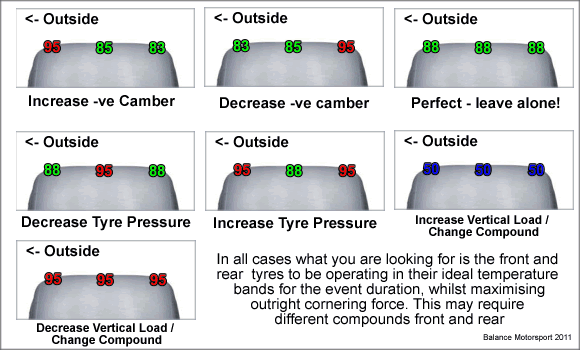Tyre Temperatures
Never has so much time been acquired, with so little outlay, as with monitoring tyre temperatures.
With a minimal outlay (£35 Infrared Pyro Gauge) and a pen and paper it is possible for your car to tell you exactly what it needs in order to go faster. Granted that £35 gauge won't be found in the hands of many top flight race engineers but it's a start. For the more professionally minded try a Spa Tyre Temperature Gauge.
So what are we looking for? Well once you have been through a full chassis and suspension modification program you need to a way of understanding how well it is all working together. If you have some kind of GPS or motion based data logger that will certainly help to show you how to take the best lines but it won't tell you how the tyres are working.
The tyre temperature should be measured at the outside, in the middle and on the inside as shown below:

In this example the outside edge of the tyre has gone beyond the working limits of the tyre. In order to restore more even temperature distribution more negative camber is required in this instance. Now completely the reverse of these readings would mean we had too much negative camber and that the inside edge was taking excessive loads.
This is the real beauty of tyre readings – they simply lead you in the right direction so that even if you've never been one for understanding all the theory the tyre temperatures will tell you what is wrong and what needs to be changed.
The diagram Fig 1. below shows you what changes are necessary depending on what your tyre temperatures tell you.
Fig 1 - Tyre Temperatures Guide - what changes are required with what readings

The most important aspect is the balance between front and rear. In a FWD car it may be necessary to run a harder front tyre compound and softer rear. Over a short race distance this may mean the driver has to cope with initial understeer until the front tyres are up to temperature, however this will be preferable to finishing the race with lots of understeer due to an overheated front compound. Often in a front wheel drive car there will be insufficient heat generated by the rear tyres necessitating a healthy increase in rear roll stiffness.
In a rear wheel drive car the balance is much easier to achieve however the typcial problem here is either an overheated outside front edge again often caused by too much front roll stiffness or not enough negative camber. On the rear sometimes wheel spin out of slower corners can overheat the driven tyres requiring either a different compound or perhaps a larger width.
Now on a circuit with left and right turns in equal measure it's usually quite easy to get a good balance of heat into all the tyres. However things are a little trickier when you arrive at a circuit with perhaps just one or two left turns. In these instances the real trick is working out which is the most important corner on the circuit (usually a bend followed by a straight) and working out whether sacrificing some speed on right handers could be favourably exchanged by the gain on left handers. In a similar vain if the course is all right handers then it probably makes sense to optimise for these corners with perhaps more negative on the outside tyres, and skewed cross weight for better performance. You will no doubt have seen how oval race cars are uniquely designed to cope with the rigours of operation in one direction.
The actual temperature range of tyres varys enormously as well, so ensure you are working within the tyres optimum range. Note with road tyres it will be trial and error as their performance at higher temperatures can be very variable as they are designed to work well when cold.
In conclusion
There is a lot more to making a quick car on a circuit than throwing money at some trick parts. It is the inter-operation of all the parts together that is important. Understanding the tyres are the starting point and designing everything around them will reap dividends and ensure you keep changes to a minimum.
The most critical aspect is managing the weight transfer between front and rear, taking note of the roll centres, to ensure that the maximum lateral force is available.
As testimony to the importance of the tyre and weight transfer see how the latest Honda Civic touring car in a recent test in EVO magazine was many seconds faster than the Ferrari 458 Italia. Now throw those same tyres on the 458 and all the other know how and of course the Ferrari would be many seconds quicker again. Correct set up allows even unpowered cars to compete with big chequebook cars. This is never more true than at club level. When you find someone quicker than the rest you'll often hear their fellow competitors being quite bitter assuming they must have a bigger engine and more Horsepower. More often than not though together with the drivers skill, it is simply attention to detail on the chassis as corner speed is far more important than straight line speed.








